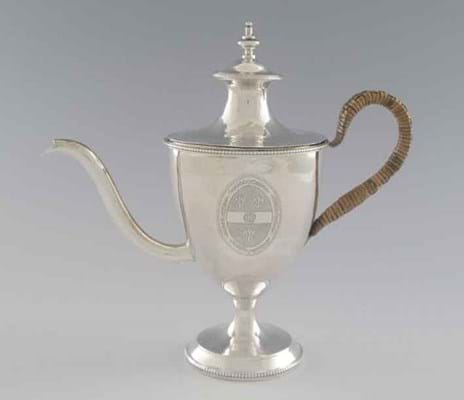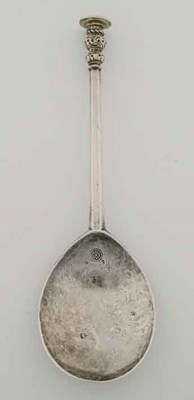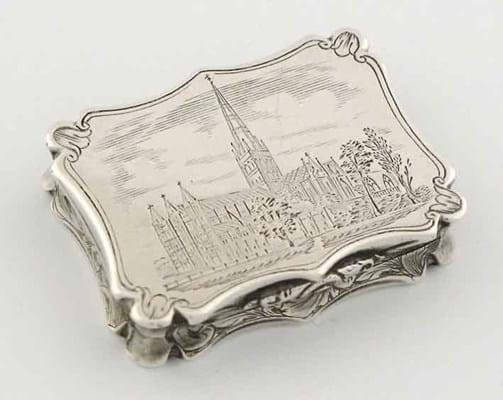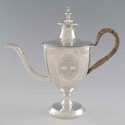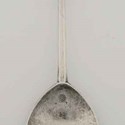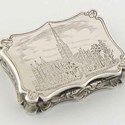That means the focus is very much upon silver smallwork and collectors' items rather than domestic plate and ergo the selling rate at this January 30-31 sale was a healthy 86 per cent.
Among the collectable forms in the spotlight at this sale was the argyle - the double-walled vessel for warming sauces that enjoyed table service in the late 18th and 19th centuries.
Six examples were consigned from the deceased estate of Margaret Evans, a local lady who had collected for years - and all but one sold above what were cautious estimates. Most eagerly contested was a neoclassical model that was marked for Hester Bateman, London 1783.
The unusual vase-shape form with beaded borders, the presence of a finely engraved armorial and the niche market for anything by Bateman, gave it wide appeal. It sold to the trade at £6200 against a £1200-1600 estimate.
A George IV example with a gadrooned base and a detachable cover with ball finial by Emes and Barnard, London 1823, weighing 16oz sold at £1800 while a plain cylindrical example with overstruck marks, probably for Philip Norman, London 1771, took £1000.
The maker of a 7in (18cm) high, 9oz Elizabeth I parcel-gilt communion cup was unidentified (it was struck once below the rim with an incuse X mark) but it was certainly of Midlands origin. The form of the bowl and the idiosyncrasies of the stem are typical of Leicestershire and Warwickshire. It fetched a mid-estimate £5500 - not a spectacular sum but it had some condition issues.
The opening section of the sale included a private collection of sugar tongs and two private collections of caddy spoons alongside some early spoons. A 7in (17.5cm) long, 1.8oz Elizabeth I/James I seal top was made in the Wessex area sometime between 1590 and 1610.
It was struck once in the bowl with a pelleted and segmented circular mark, had a large gilt Salisbury A type terminal, and was pricked I.G. over 1651. A very nice example of a spoon found all over the South of England, it prompted one private collector to take bidding to a triple estimate £3400.
Another lot with a Salisbury connection was a Victorian-era castle top vinaigrette engraved with a view of the cathedral by Nathaniel Mills, Birmingham 1843.
Of the many highly collectable objects that the Mills family of silversmiths produced in the 19th century, the 'castle top' examples depicting landmark buildings are always among the most popular.Those with the scarcest scenes have made over £5000. Woolley and Wallis attracted lots of private local interest for this vinaigrette but it was also competed by the London trade, who secured it at £3800.
Novelties are not always easy to value. While a £300-400 estimate was way off the mark for this vinaigrette, then the £1500-1800 estimate proved too daunting for a pair of rare Edwardian doll pepperettes that failed to find a buyer. Specialist Lucy Grazier said they attracted little interest either before the sale or on the day.
Hornsby Pepperettes
Conversely, a pair of 2.5in (6.5cm) long, 4oz Edwardian novelty pepperettes cast as two terriers by William Hornsby from London, 1906, had a more tempting £300-400 estimate and fetched £1400. Widely admired by corkscrew collectors was a 4in (10cm) long 18th century Dutch silver corkscrew modelled with a horse to the handle that unscrewed to reveal a toothpick.
The date letter was obscured and it was struck with two later duty marks but it was most likely made in Amsterdam c.1760.
It fetched a double estimate £3300.
George III Tea Set
The National Maritime Museum will be the new home for a 37.5oz George III three-piece tea set by Robert & Samuel Hennel, London. The teapot, relatively plain save a stag's head finial, was inscribed Presented to Sir Home Popham K.M. by the Hon, the Court of Directors of the East India Company 1803.
Sir Popham was a British Admiral who fought in the French Revolutionary and Napoleonic Wars. He is remembered particularly for developing the signal code that the Royal Navy adopted in 1803.The museum secured it at the low £2000 estimate.
The expected highlight of the day, a rare c.1699, 8in (20cm) high William III provincial lighthouse caster by William Clare of Warminster estimated at £9000-12,000, failed to sell.
The buyer's premium was 17.5%

